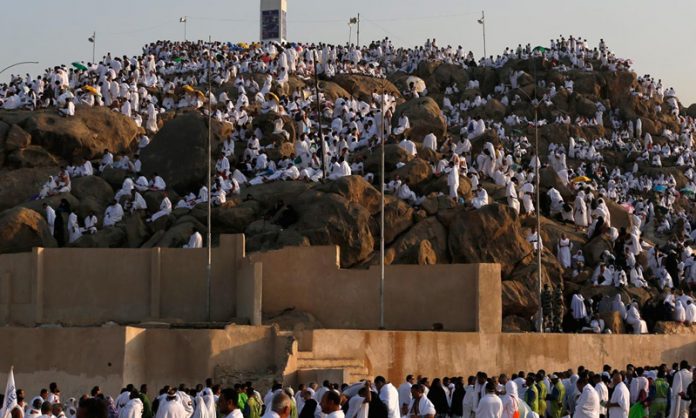MOUNT ARAFAT, Saudi Arabia: The Hajj reached its high point Sunday when Muslims from across the world converged on a stoney hill in Saudi Arabia, a year after the worst tragedy in the pilgrimage’s history.
More than 1.8 million gathered from sunrise at the hill and a vast surrounding plain known as Mount Arafat, about 15 kilometres (nine miles) from Makkah.
They were spending the most important day of the annual Hajj in prayer and reading from the Holy Quran.
Arafat is the site where the Prophet Mohammed (PBUH) gave his last sermon about 14 centuries ago after leading his followers on the pilgrimage.
“I have the impression of standing exactly in front of God, said Khadem Ndyaye, 47, of Senegal.
“Muslims came here from everywhere and we are all the same. If all the world was like that, there wouldn’t be any war. Here, we feel that Islam is a religion of peace.”
Indian pilgrim Mohammed Arafan, 40, said he feels “chosen by God” for being able to perform the Hajj.
“It’s beautiful to see the Muslims of the world pray together here.”
At midday prayer hundreds of thousands prostrated themselves, men and women side-by-side, in wide alleys that run between prefabricated pilgrim lodgings.
For the first time in years, Saudi Arabia’s Grand Mufti Abdul Aziz al-Sheikh did not give his traditional Arafat sermon.
Okaz newspaper cited health reasons but Sheikh still attended the sermon given in his place by Abdul Rahman al-Sudais, Imam of Makkah’s Grand Mosque.
Under multicoloured parasols to protect against the burning sun, the mass of people move through broad streets which are closed to traffic around Mount Arafat.
Throughout the day the faithful chant a traditional Hajj incantation, “God, here I am.”
From a distance, the hill appeared a snowy white from the seamless two-piece white garment, Ihram, worn by male pilgrims.
They come from every corner of the globe, but Indonesia — the most populous Muslim nation — has the largest contingent.
– Safety measures –
In stifling heat, trucks loaded with bottled water were stationed throughout, and pilgrims doused themselves.
Empty bottles and leftover meals littered the ground as ambulances patrolled.
After sunset they would move to Muzdalifah, halfway between Arafat and Mina, to gather 49 pebbles for a symbolic stoning of the devil which begins Monday, in the last major rite of hajj.
During that ritual in Mina last year a stampede killed roughly 2,300 people who were on their way to throw their stones at the Jamarat Bridge.
Saudi authorities have taken a number of safety measures. Among these is the distribution of a bracelet which stores pilgrims’ personal data. Roads have also been widened in the Jamarat area, newspapers reported.
Pilgrims have told AFP they feel safe and noticed organisational improvements.
On Sunday, helicopters monitored the crowd flow from the skies, while on the ground, police on foot, motorbike, and all-terrain vehicles directed pedestrian movement.
At the sacred hill itself, police sometimes had to use their bodies to block the flow of pilgrims and avoid bottlenecks.
Crown Prince Mohammed bin Nayef, the interior minister and chairman of the Hajj committee, was in Mina to help supervise “the services being provided to the pilgrims,” the official Saudi Press Agency said.





